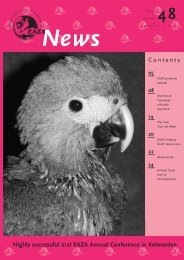EAZA Tiger Campaign extended to 2004 Contents - European ...
EAZA Tiger Campaign extended to 2004 Contents - European ...
EAZA Tiger Campaign extended to 2004 Contents - European ...
Create successful ePaper yourself
Turn your PDF publications into a flip-book with our unique Google optimized e-Paper software.
ZÜRICH - SWITZERLAND<br />
A female two-<strong>to</strong>ed sloth (Choloepus didactylus) that arrived<br />
in Zürich in 1989 from Guyana gave birth <strong>to</strong> her eighth<br />
young on 12 May 2003. Five previous young were successfully<br />
reared, one died shortly after birth and one was stillborn.<br />
The female was examined twice using x-rays and ultrasound<br />
during this last pregnancy. This was the fourteenth two-<strong>to</strong>ed<br />
sloth birth at our zoo.<br />
A new Mongolian wolf (Canis lupus chanco) exhibit opened<br />
in February 2002. The male and female were imported as<br />
young animals directly from Mongolia in Autumn 2001.<br />
Reproduction has already occurred, after a gestation period<br />
of 64 days three pups were born on 18 April 2003.<br />
Following the opening of the new Amur tiger exhibit, the<br />
former tiger indoor enclosure and part of the outdoor enclosure<br />
was transformed in<strong>to</strong> a hornbill exhibit. We received a<br />
pair of Malayan hornbills (Anthracoceros malayanus) in<br />
November 2001. The female came from Avifauna, Alphen<br />
a/d Rijn, and the male from the Dutch Hornbill Foundation.<br />
Both birds were hatched in 1999. The pair mated and<br />
showed increased interest in a nest hole at the end of<br />
January 2003, and by 5 February the female had entered<br />
the cavity and sealed the entrance. A changed feeding behaviour<br />
of the male on 17 March and parts of eggshells found<br />
on 28 March gave us the hope that chick(s) may have<br />
hatched. Three chicks finally left the nest cavity <strong>to</strong>gether<br />
with the female in mid-May.<br />
It had been observed that our female spangled cotinga<br />
(Cotinga cayana) was only sporadically visible in the free-flight<br />
hall of the Exotarium. Nevertheless it was a great surprise<br />
when on 11 March 2003 the female was discovered accompanied<br />
by a newly fledged chick. This is the first successful<br />
reproduction of this species at Zoo Zürich. In the meantime<br />
the female again is sitting in her well-hidden nest.<br />
The first Galapagos <strong>to</strong>r<strong>to</strong>ise (Geochelone nigra) hatched at<br />
our zoo in 1989, and 14 years later we note the hatching of<br />
number 48! Eight hatchlings from a clutch of ten eggs laid<br />
on 29 December 2002 emerged in the incuba<strong>to</strong>r between<br />
4 and 22 May 2003. All offspring <strong>to</strong> date have been<br />
produced by the same pair.<br />
Source: Robert Zingg<br />
Births and Hatchings<br />
Pho<strong>to</strong>: Sam Furrer/Zoo Zürich<br />
CHESTER - UNITED KINGDOM<br />
Red birds of paradise occur only on several small islands off<br />
the coast of Papua (the Indonesian governed western half of<br />
New Guinea; formerly Irian Jaya) where they are considered<br />
near-threatened in the wild. The birds have a very restricted<br />
distribution and threats include habitat destruction and trapping<br />
for skins.<br />
Very few birds of paradise are kept in zoos and the Studbook<br />
for Red Birds of Paradise and world centre for breeding these<br />
is based at the Bronx Zoo, New York. Chester Zoo received a<br />
pair of red birds of paradise (Paradisea rubra) on breeding<br />
loan from the Bronx Zoo in May 1999. Both birds had been<br />
bred in New York, the male hatched in February 1998 and the<br />
female in May 1998. Two of our bird staff went <strong>to</strong> New York<br />
and gained experience<br />
by working <strong>to</strong>gether with<br />
the bird staff at the Bronx<br />
Zoo before accompanying<br />
the birds of paradise<br />
on their return <strong>to</strong><br />
Chester. Special offshow<br />
facilities were built<br />
at Chester Zoo <strong>to</strong> house<br />
these birds and later in<br />
the Islands In Danger<br />
exhibit where these<br />
birds were transferred<br />
in April 2000.<br />
Birds of paradise take many years <strong>to</strong> attain full breeding<br />
plumage and the male at Chester, which is now just over five<br />
years old, only recently acquired tail streamers but otherwise<br />
remains in an immature plumage. The male and female which<br />
up until recently had been living <strong>to</strong>gether were separated at<br />
the beginning of March this year as it is known that males<br />
may interfere with breeding attempts by destroying any nests<br />
built by hens. Once the hen was observed nest building she<br />
was allowed short daily visits on 10 -14 April <strong>to</strong> join the<br />
male in his quarters, returning <strong>to</strong> her own breeding aviary<br />
afterwards. The hen laid two eggs, the first on 15 April<br />
and the second two days later. Notwithstanding his lack of<br />
breeding plumage our male proved his fertility when the first<br />
chick hatched on 1 May 2003 and the second chick hatched<br />
one <strong>to</strong> two days later.<br />
The hen reared the chicks on a diet of insects (mainly wax<br />
moth larvae and locusts) and fruit, being especially partial <strong>to</strong><br />
blueberries. Both chicks fledged on 18 May and although now<br />
Pho<strong>to</strong>: Chester Zoo<br />
<strong>EAZA</strong> News 43 – 2003<br />
17<br />
July - August - September

















